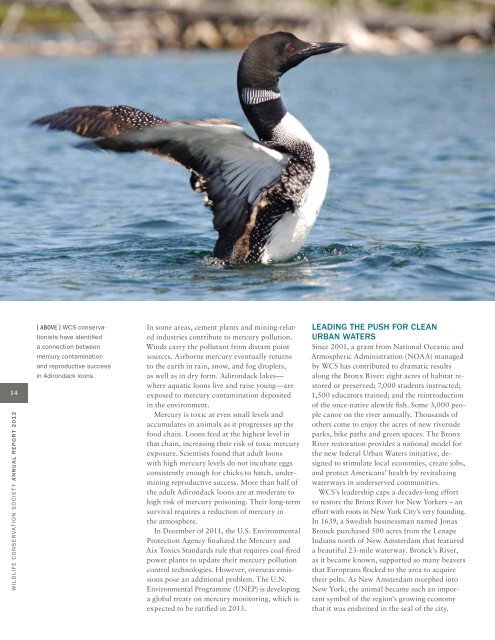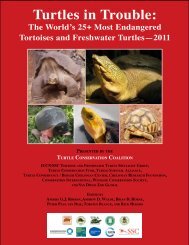WCS Annual Report 2012 - Wildlife Conservation Society
WCS Annual Report 2012 - Wildlife Conservation Society
WCS Annual Report 2012 - Wildlife Conservation Society
You also want an ePaper? Increase the reach of your titles
YUMPU automatically turns print PDFs into web optimized ePapers that Google loves.
14<br />
wildlife conservation society <strong>Annual</strong> <strong>Report</strong> <strong>2012</strong><br />
[ above ] <strong>WCS</strong> conservationists<br />
have identified<br />
a connection between<br />
mercury contamination<br />
and reproductive success<br />
in Adirondack loons.<br />
In some areas, cement plants and mining-related<br />
industries contribute to mercury pollution.<br />
Winds carry the pollutant from distant point<br />
sources. Airborne mercury eventually returns<br />
to the earth in rain, snow, and fog droplets,<br />
as well as in dry form. Adirondack lakes—<br />
where aquatic loons live and raise young—are<br />
exposed to mercury contamination deposited<br />
in the environment.<br />
Mercury is toxic at even small levels and<br />
accumulates in animals as it progresses up the<br />
food chain. Loons feed at the highest level in<br />
that chain, increasing their risk of toxic mercury<br />
exposure. Scientists found that adult loons<br />
with high mercury levels do not incubate eggs<br />
consistently enough for chicks to hatch, undermining<br />
reproductive success. More than half of<br />
the adult Adirondack loons are at moderate to<br />
high risk of mercury poisoning. Their long-term<br />
survival requires a reduction of mercury in<br />
the atmosphere.<br />
In December of 2011, the U.S. Environmental<br />
Protection Agency finalized the Mercury and<br />
Aix Toxics Standards rule that requires coal-fired<br />
power plants to update their mercury pollution<br />
control technologies. However, overseas emissions<br />
pose an additional problem. The U.N.<br />
Environmental Programme (UNEP) is developing<br />
a global treaty on mercury monitoring, which is<br />
expected to be ratified in 2013.<br />
Leading the Push for Clean<br />
Urban Waters<br />
Since 2001, a grant from National Oceanic and<br />
Atmospheric Administration (NOAA) managed<br />
by <strong>WCS</strong> has contributed to dramatic results<br />
along the Bronx River: eight acres of habitat restored<br />
or preserved; 7,000 students instructed;<br />
1,500 educators trained; and the reintroduction<br />
of the once-native alewife fish. Some 3,000 people<br />
canoe on the river annually. Thousands of<br />
others come to enjoy the acres of new riverside<br />
parks, bike paths and green spaces. The Bronx<br />
River restoration provides a national model for<br />
the new federal Urban Waters initiative, designed<br />
to stimulate local economies, create jobs,<br />
and protect Americans’ health by revitalizing<br />
waterways in underserved communities.<br />
<strong>WCS</strong>’s leadership caps a decades-long effort<br />
to restore the Bronx River for New Yorkers – an<br />
effort with roots in New York City’s very founding.<br />
In 1639, a Swedish businessman named Jonas<br />
Bronck purchased 500 acres from the Lenape<br />
Indians north of New Amsterdam that featured<br />
a beautiful 23-mile waterway. Bronck’s River,<br />
as it became known, supported so many beavers<br />
that Europeans flocked to the area to acquire<br />
their pelts. As New Amsterdam morphed into<br />
New York, the animal became such an important<br />
symbol of the region’s growing economy<br />
that it was enshrined in the seal of the city.







![RaLand / SeaScape [PDF] - Wildlife Conservation Society](https://img.yumpu.com/49974326/1/190x245/raland-seascape-pdf-wildlife-conservation-society.jpg?quality=85)









